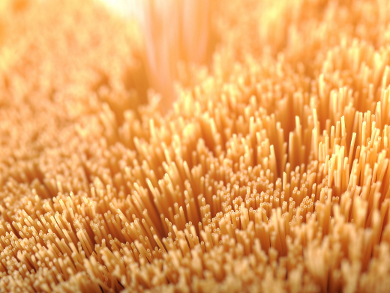Evonik has developed a hollow-fiber membrane for efficient separation of nitrogen from air. With a market share exceeding 40 %, nitrogen has the highest market volume in the gas separation sector.
The SEPURAN® N2 hollow-fiber membrane consists of polyimide, a high-performance polymer that is highly chemically and thermally stable. It is produced by Evonik at its Lenzing, Austria, site. The hollow fibers, which resemble long and very thin tubes of pasta (see picture), are bundled together, embedded in a resin developed specially for the purpose, and enclosed in a stainless steel module. The membrane module, approximately 1.3 m long, contains several tens of thousands of these fine tubes, each of diameter 0.5 mm.
For separation of nitrogen, compressed air is fed into the hollow-fiber membranes. Due to their smaller size, oxygen molecules can pass through the membrane more easily than nitrogen molecules. This leads to enrichment of nitrogen to the desired purity inside the hollow fibers, while an O2-rich airstream is generated on the outside. The lower the flow rate of the incoming air, the higher is the quality of the nitrogen. For many applications technical nitrogen of purity 95 to 98 % is adequate.
SEPURAN® N2 membranes offer a lower-cost solution than other membranes due to the high capacity and low air requirement. A smaller compressor reduces investment costs as well as energy consumption and the modular structure means that the system can be used flexibly. The technology can be combined with existing systems, for example, to meet peak demand, or directly connected to compressed air systems to supply nitrogen.
- Evonik Industries AG, Essen, Germany




